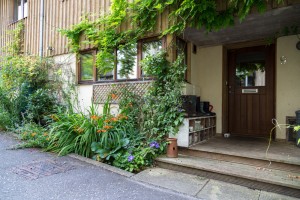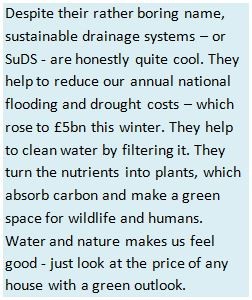How will Britain soak up new housing?

Blog post by Peter Morris, WWT's Head of PR & Campaigning
“Absorbent” is good. It must be, because advertisers use it all the time as a positive word. From kitchen towels to nappies, “absorbent” promises to lock away nasty liquids leaving us clean and dry.
So what is Britain’s best absorbent product? Well possibly Britain itself. Collectively, the biggest source of liquid we need to clear up is rainfall – millions of gallons of it falling on us every year. And it’s the country itself that absorbs all that, like a huge Britain-shaped sponge.
This vast amount of water percolates slowly and endlessly through our soils, drip-feeding into our rivers so they don’t become overwhelmed and flood when it rains, or run dry when it doesn’t.
Or at least that’s the balance that nature is always working towards. The trouble is, we keep making Britain less absorbent. For example this week the House of Lords will debate ways to make it easier to build a million new homes by 2020.
These homes are much needed. But they will turn a significant square mileage of absorbent mud and soil into non-permeable tarmac and roof tiles. The run-off will be directed down drains towards, well, whoever is downhill. If you add these homes to all the other buildings already existing in a river catchment, suddenly the people at the bottom of the catchment have a lot of water being piped at them very fast with obvious knee-deep consequences.
 We’re always going to need more buildings, so what to do? An answer came in the Government’s report into ways to stop the awful 2007 floods happening again (if you can remember which ones those were...) which cost our economy more than £3bn.
We’re always going to need more buildings, so what to do? An answer came in the Government’s report into ways to stop the awful 2007 floods happening again (if you can remember which ones those were...) which cost our economy more than £3bn.
The report recognised that under every new building there is a huge capacity of soil and rock stretching for miles underground. New buildings could simply drain their run-off into the ground to soak away slowly, or be taken up by plants or stored in ponds, rather than rushing it through pipes to a flooding pressure point downstream.
Gardeners have been doing this for years by either pointing their drainpipe into the garden, or into a water butt from which they water the garden. You can even ask your water supplier for a discount on your bill, because you handle your own drainage. It’s simple and cheap.

The Government accepted the idea and it went into law in 2010, to be implemented in 2014. The consultation said “all the available evidence is that sustainable drainage systems are generally cheaper to build; and maintaining them will be cheaper (or no more expensive) than the same cost as is required to maintain conventional drainage at present”.
But it transpired that you can lead a developer to water, but you can’t make him not build a pipe to drain it. Local council boards were supposed to advise developers on concerns around design and maintenance. But in a time when headcounts were being reduced in local Government, and developers were being urged to build fast and move on to the next job, the momentum faltered. Implementation was copiously watered down and the majority of new developments remain exempted from the flood prevention measure it was designed to provide.
Was it a missed opportunity? Maybe not. This week the House of Lords will consider reinstating the original idea that all new buildings handle drainage on site unless it’s not possible. The Welsh Government meanwhile has a 49 page set of SuDS guidelines ready (compared to England’s two page version!) in case the law is changed. The Environment Agency has published a report on incorporating SuDS into existing buildings.
The advantages of SuDS are being recognised. All that it takes is for politicians and developers to be absorbent to the idea of them.



